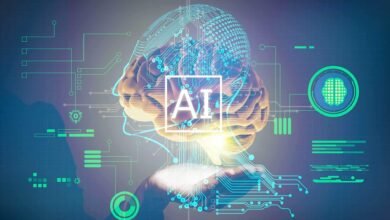How Blockchain Can Strengthen Customer Trust in AI
Discover how blockchain technology strengthens customer trust in AI through transparency, accountability, and data integrity. Learn proven strategies.

The rapid advancement of artificial intelligence (AI) has transformed industries worldwide, revolutionizing everything from healthcare diagnostics to financial services. However, this technological boom has also created a significant challenge: the erosion of customer trust in AI systems. Recent surveys reveal that 52% of Americans are more concerned than excited about AI in daily life, highlighting a critical trust deficit that threatens the widespread adoption of AI technologies.
The core issue lies in AI’s inherent opacity—the infamous “black box” problem where users cannot understand how AI systems make decisions. This lack of transparency breeds skepticism, particularly when AI systems impact critical areas such as loan approvals, medical diagnoses, and employment decisions. Customers demand accountability, fairness, and explainability from AI systems, yet traditional centralized AI models struggle to provide these assurances.
Enter blockchain technology—a revolutionary solution that promises to bridge the trust gap between AI systems and their users. Blockchain technology, with its decentralized, immutable, and transparent characteristics, presents a potential solution to enhance AI transparency and auditability. By creating an immutable record of AI decisions, data sources, and model development processes, blockchain can transform opaque AI systems into transparent, accountable, and trustworthy technologies.
The convergence of blockchain and AI represents more than just a technological integration—it’s a fundamental shift toward ethical AI governance. This combination addresses multiple trust challenges simultaneously: ensuring data integrity, providing audit trails, preventing manipulation, and creating verifiable accountability mechanisms. As businesses increasingly recognize that customer trust is essential for AI adoption, the blockchain-AI synergy emerges as a critical competitive advantage.
This comprehensive guide explores how organizations can leverage blockchain transparency to strengthen customer confidence in AI systems, examine real-world implementations, and understand the practical steps needed to build trustworthy AI ecosystems that customers can confidently embrace.
Understanding the AI Trust Crisis
The Scope of Customer Distrust
The AI trust crisis extends far beyond simple skepticism—it represents a fundamental barrier to technological progress. Current AI systems operate as black boxes, making decisions through complex algorithms that remain incomprehensible to users. This opacity creates anxiety, particularly when AI influences critical life decisions such as insurance claims, credit approvals, or medical treatments.
Customer trust in AI erodes when users cannot understand or verify AI decision-making processes. Without transparency, customers have no way to identify potential biases, errors, or manipulations within AI systems. This uncertainty becomes particularly problematic in regulated industries where accountability and explainability are legal requirements.
Common Trust Barriers in AI
Several key factors contribute to declining customer confidence in AI technologies:
Algorithmic bias represents one of the most significant trust barriers. AI models trained on biased datasets can perpetuate and amplify existing societal inequalities, leading to discriminatory outcomes. Without transparent insight into training data and decision logic, customers cannot assess whether AI systems treat them fairly.
Data privacy concerns further undermine trust. Customers worry about how AI systems collect, process, and utilize their personal information. The lack of visibility into data handling practices creates uncertainty about privacy protection and potential misuse of sensitive information.
Decision unpredictability poses another challenge. When AI systems produce inconsistent or unexpected results, customers lose confidence in their reliability. The inability to understand why AI made specific decisions makes it impossible for users to predict or trust future outcomes.
Lack of recourse compounds these issues. Traditional AI systems provide no mechanism for challenging or appealing automated decisions. This powerlessness frustrates customers and reinforces their perception that AI systems operate beyond human oversight or control.
Blockchain Fundamentals for AI Trust
Core Blockchain Properties
Blockchain technology offers unique characteristics that directly address AI trust challenges. Understanding these fundamental properties reveals why blockchain serves as an ideal trust layer for AI systems.
Immutability ensures that once information is recorded on a blockchain, it cannot be altered or deleted. This property provides crucial assurance for AI governance, as all decisions, processes, and data interactions remain permanently accessible for audit and verification.
Decentralization eliminates single points of failure and control. Unlike traditional centralized systems where one entity controls all data and decisions, blockchain distributes authority across multiple nodes. This decentralized approach prevents manipulation and ensures that no single party can compromise the integrity of AI records.
Transparency allows all network participants to view and verify blockchain transactions. This openness enables customers, regulators, and stakeholders to examine AI processes, building confidence through visibility and accountability.
Consensus mechanisms ensure that all network participants agree on the validity of transactions before they are recorded. This collective verification process adds an additional layer of security and trustworthiness to AI-related records.
Blockchain as a Trust Infrastructure
Blockchain transparency creates a foundation for trustworthy AI by establishing verifiable accountability mechanisms. When AI systems record their decisions, data sources, and processes on blockchain networks, they create an immutable audit trail that customers can access and verify.
This trust infrastructure addresses customer concerns by providing clear visibility into AI operations. Instead of accepting AI decisions on faith, customers can examine the decision-making process, understand the factors involved, and verify that the system operates fairly and consistently.
Smart contracts enhance this trust infrastructure by automatically executing predefined rules and conditions. These self-executing contracts can enforce AI governance standards, ensure compliance with regulations, and provide automatic remediation when AI systems deviate from acceptable parameters.
How Blockchain Enhances AI Transparency
Creating Immutable Decision Records
Blockchain technology revolutionizes AI transparency by creating permanent, tamper-proof records of every AI decision. When AI systems integrate with blockchain networks, they automatically log critical information including input data, decision rationale, confidence levels, and output results. This immutable record ensures that customers can always trace and verify AI decisions.
The process works by hashing AI decision data and storing these cryptographic fingerprints on the blockchain. Key AI actions can be hashed and logged in a public or permissioned blockchain, providing an audit trail. This balances transparency with privacy and creates a layer of accountability. This approach maintains customer privacy while enabling comprehensive auditability.
For example, when an AI system approves or denies a loan application, it records the decision criteria, data sources used, and algorithmic reasoning on the blockchain. Customers can later access this information to understand exactly why specific decisions were made, building trust through transparency.
Data Provenance and Integrity
Data integrity represents a critical component of AI trustworthiness. Customers need assurance that AI systems use accurate, unbiased, and legitimate data sources. Blockchain transparency addresses this need by creating verifiable records of data provenance—tracking information from its original source through processing to final utilization.
Blockchain networks can timestamp and authenticate data as it enters AI systems, creating an unbroken chain of custody. This data provenance capability enables customers to verify that AI decisions are based on legitimate, high-quality information rather than manipulated or biased datasets.
Medical AI applications particularly benefit from this approach. Medical records remain in a secure database, but their cryptographic hashes are stored on-chain, enabling proof-of-integrity without exposing sensitive patient information. This combination of privacy and verifiability builds customer confidence in AI-driven healthcare decisions.
Real-Time Audit Capabilities
Traditional AI auditing requires extensive post-hoc analysis that may take weeks or months to complete. Blockchain integration enables real-time auditability, allowing customers and stakeholders to monitor AI performance continuously rather than waiting for periodic reviews.
This real-time audit trail capability empowers customers to identify potential issues immediately. If an AI system begins producing unexpected or concerning results, blockchain records enable rapid investigation and resolution. This responsive approach to AI governance significantly enhances customer trust by demonstrating proactive oversight.
Building Accountable AI Systems
Automated Compliance Monitoring
Blockchain technology enables automated compliance monitoring that ensures AI systems adhere to regulatory requirements and ethical standards continuously. Smart contracts can monitor AI behavior in real-time, automatically flagging violations and triggering corrective actions when systems deviate from acceptable parameters.
This automated approach addresses a critical trust barrier—customers’ concern that AI systems operate without adequate oversight. By implementing AI accountability through blockchain-based monitoring, organizations demonstrate their commitment to responsible AI governance.
FICO’s blockchain implementation provides a compelling example of this approach. FICO developed a private blockchain that automated documentation and standards in model development. This approach sped its time to market with AI and analytic innovation, but has also helped keep new models in production; blockchain has reduced support issues and model recalls by over 90%.
Stakeholder Verification Systems
Blockchain-based AI systems can implement multi-stakeholder verification processes that distribute oversight responsibility across various parties. Instead of relying on single entities to monitor AI performance, blockchain enables customers, regulators, auditors, and other stakeholders to participate in verification processes.
This distributed verification approach builds customer trust by ensuring that multiple independent parties validate AI system performance. Customers gain confidence knowing that various stakeholders monitor AI operations and can identify potential issues or biases.
Decentralized verification also reduces the risk of systematic failures or cover-ups. When multiple parties independently verify AI performance using blockchain records, it becomes virtually impossible for organizations to hide AI malfunctions or manipulate performance metrics.
Bias Detection and Mitigation
Algorithmic bias represents one of the most significant barriers to customer trust in AI. Blockchain technology can help detect and mitigate bias by creating transparent records of AI training data, decision patterns, and outcome distributions across different demographic groups.
By analyzing blockchain-recorded AI decisions, stakeholders can identify statistical patterns that indicate potential bias. Blockchain’s transparent consensus mechanisms promote inclusive and diverse decision-making. Deploying a distributed blockchain network reduces biases, leading to impartial and unbiased AI outcomes.
This bias detection capability enables proactive correction rather than reactive remediation. Organizations can identify and address bias issues before they impact customers significantly, building trust through demonstrated commitment to fairness and equality.
Practical Implementation Strategies
Choosing the Right Blockchain Architecture
Implementing blockchain for AI trust requires careful consideration of architectural choices that balance transparency, privacy, and performance requirements. Organizations must evaluate public versus private blockchain networks, consensus mechanisms, and integration approaches based on their specific use cases and customer needs.
Public blockchains offer maximum transparency and decentralization, making them ideal for applications where customer trust depends on complete openness. However, public networks may present scalability and privacy challenges for AI systems processing large volumes of sensitive data.
Private or consortium blockchains provide greater control and privacy while maintaining the trust benefits of distributed ledger technology. These networks enable selective transparency—sharing relevant information with customers and stakeholders while protecting proprietary algorithms and sensitive data.
Hybrid approaches combine public and private blockchain elements to optimize both transparency and performance. Organizations can record essential AI governance information on public networks while maintaining detailed operational data on private chains.
Integration with Existing AI Infrastructure
Successful blockchain-AI integration requires seamless connection with existing AI development and deployment infrastructure. Organizations should implement blockchain recording without disrupting current AI workflows or significantly impacting system performance.
API-based integration represents the most practical approach for most organizations. AI systems can send decision records to blockchain networks through standardized APIs, enabling blockchain recording without requiring fundamental changes to existing AI architectures.
Microservices architecture facilitates blockchain integration by creating modular, independent services that handle blockchain interactions. This approach minimizes system complexity and enables gradual implementation across different AI applications.
Event-driven architectures can automatically trigger blockchain recording based on specific AI activities, ensuring comprehensive documentation without requiring manual intervention or process changes.
Privacy-Preserving Transparency
Balancing transparency with privacy protection represents a critical challenge in blockchain-AI implementations. Customers want visibility into AI decision-making processes while maintaining protection of their sensitive personal information.
Zero-knowledge proofs enable verification of AI decisions without revealing underlying data. Organizations can prove that AI systems followed proper procedures and used legitimate data sources without exposing customer information or proprietary algorithms.
Homomorphic encryption allows computation on encrypted data, enabling AI processing while maintaining data confidentiality. Blockchain networks can record proof of processing without storing sensitive information directly on the ledger.
Data hashing techniques create cryptographic fingerprints of data that enable integrity verification without data exposure. Data remains in secure storage, but cryptographic hashes are stored on-chain. This enables proof-of-integrity without revealing the data itself.
Industry Applications and Case Studies
Financial Services Transformation
The financial services industry leads blockchain-AI adoption due to strict regulatory requirements and high customer trust demands. Financial AI systems must provide clear explanations for credit decisions, fraud detection, and risk assessments to satisfy both regulatory compliance and customer expectations.
Anomaly Detection in Financial Transactions: Research has integrated blockchain with Explainable AI methods, such as Shapley Additive ExPlanation (SHAP), to detect fraudulent Bitcoin transactions. This allows stakeholders to verify AI-driven fraud detection decisions. This implementation demonstrates how blockchain enables customers to understand and trust AI-powered security measures.
Credit scoring represents another significant application area. Traditional credit scoring algorithms operate as black boxes, leaving customers uncertain about factors influencing their credit decisions. Blockchain-enabled credit AI can provide transparent explanations while maintaining data privacy, helping customers understand credit decisions and potentially improve their scores.
Healthcare AI Accountability
Healthcare applications demand the highest levels of AI accountability due to life-and-death consequences of medical AI decisions. Patients and healthcare providers require complete confidence in AI-driven diagnostics, treatment recommendations, and drug discovery processes.
Healthcare Transparency: AI-driven diagnostic models are being recorded on the blockchain to provide verifiable reasoning for medical predictions, allowing healthcare professionals to audit and validate AI recommendations. This approach enables doctors and patients to understand AI diagnostic reasoning, building trust in AI-assisted healthcare decisions.
Medical AI blockchain implementations can track training data sources, model validation results, and decision rationales while maintaining patient privacy through cryptographic techniques. This comprehensive documentation enables healthcare providers to confidently rely on AI assistance while providing patients with transparency about their care.
Supply Chain Intelligence
Supply chain AI systems must balance efficiency optimization with transparency requirements from consumers, regulators, and business partners. Blockchain technology enables comprehensive supply chain visibility while protecting competitive information.
Supply Chain Transparency: AI-driven decision-making in agriculture supply chains is being stored on the blockchain, ensuring that farmers and distributors can track how AI models predict crop yields and demand, improving efficiency and fairness. This implementation demonstrates how blockchain can build trust across complex multi-stakeholder environments.
Consumer goods companies can use blockchain-AI systems to provide customers with detailed product journey information, including AI-driven quality assessments, sustainability metrics, and authenticity verification. This transparency builds customer trust by enabling informed purchasing decisions.
Overcoming Implementation Challenges
Technical Integration Complexities
Implementing blockchain for AI requires addressing significant technical challenges including scalability limitations, integration complexity, and performance optimization. Organizations must develop comprehensive strategies to overcome these obstacles while maintaining system reliability and user experience.
Scalability solutions including layer-2 networks, sidechains, and off-chain computation can help manage the high transaction volumes generated by AI systems. These approaches enable blockchain recording without compromising AI system performance or creating prohibitive costs.
API standardization simplifies integration by providing consistent interfaces between AI systems and blockchain networks. Industry consortiums are developing standard protocols that enable seamless blockchain-AI communication across different platforms and vendors.
Performance optimization techniques including batch processing, asynchronous recording, and selective logging can minimize the performance impact of blockchain integration. Organizations should implement these optimizations based on their specific AI workloads and performance requirements.
Regulatory Compliance Considerations
AI governance through blockchain must align with existing and emerging regulatory frameworks across different jurisdictions. Organizations need to ensure that their blockchain-AI implementations satisfy regulatory requirements while enabling the flexibility needed for innovation and adaptation.
Data residency requirements may limit blockchain network choices, particularly for organizations operating in multiple countries with different data protection laws. Hybrid blockchain architectures can help address these requirements by enabling local data storage while maintaining global transparency.
Audit requirements must be designed into blockchain-AI systems from the beginning. Organizations should work with regulatory bodies to ensure that their blockchain records satisfy audit and compliance requirements without requiring expensive post-hoc modifications.
Cost-Benefit Analysis
Organizations must carefully evaluate the costs and benefits of blockchain-AI integration to ensure sustainable implementation. While blockchain provides significant trust benefits, it also introduces additional complexity and operational costs that must be justified through business value.
Implementation costs include blockchain infrastructure, integration development, staff training, and ongoing operational expenses. Organizations should develop comprehensive cost models that account for all implementation and operational requirements.
Trust benefits can be quantified through metrics including customer retention, reduced support costs, decreased regulatory penalties, and improved market positioning. Many organizations find that trust benefits significantly outweigh implementation costs, particularly in highly regulated industries.
Competitive advantages from trustworthy AI can justify blockchain investments through market differentiation, premium pricing opportunities, and accelerated customer adoption. Organizations that successfully implement blockchain-AI trust systems often gain significant competitive advantages over traditional AI providers.
Future Implications and Trends
Emerging Technologies Convergence
The convergence of blockchain technology, artificial intelligence, and other emerging technologies creates unprecedented opportunities for building customer trust. Internet of Things (IoT) devices, edge computing, and 5G networks will enable more sophisticated blockchain-AI implementations that provide real-time transparency and accountability.
Decentralized AI networks powered by blockchain technology will enable collaborative AI development while maintaining transparency and accountability. These networks will allow multiple organizations to contribute to AI model development while ensuring that all participants can verify the integrity and fairness of the resulting systems.
Quantum-resistant cryptography will ensure that blockchain-AI trust systems remain secure as quantum computing capabilities advance. Organizations should plan for quantum-resistant implementations to protect long-term trust investments.
Regulatory Evolution
Regulatory frameworks for AI accountability will continue evolving to address emerging challenges and opportunities. Organizations implementing blockchain-AI systems today will be better positioned to adapt to future regulatory requirements and may even help shape regulatory development through demonstrated best practices.
Global standards for blockchain-AI integration are emerging through international cooperation and industry collaboration. Organizations should monitor these developments and align their implementations with emerging standards to ensure interoperability and compliance.
Certification programs for trustworthy AI will likely incorporate blockchain-based transparency requirements. Organizations with existing blockchain-AI implementations will have significant advantages in obtaining these certifications and demonstrating compliance with trust standards.
Market Transformation
The market for AI services will increasingly differentiate based on trust and transparency capabilities. Organizations that successfully implement blockchain-AI trust systems will capture growing market demand for accountable, explainable AI solutions.
Customer expectations for AI transparency will continue rising as awareness of AI capabilities and limitations grows. Blockchain-enabled transparency will transition from competitive advantage to market requirement as customers demand verifiable accountability from AI providers.
Investment flows will increasingly favor organizations demonstrating strong AI governance capabilities. ESG (Environmental, Social, and Governance) investing principles will drive capital toward companies that can demonstrate responsible AI development and deployment practices through blockchain-based transparency.
Best Practices for Implementation
Stakeholder Engagement Strategies
Successful blockchain-AI implementation requires comprehensive stakeholder engagement that addresses the needs and concerns of customers, employees, regulators, and business partners. Organizations should develop targeted communication strategies that explain the benefits and address potential concerns about blockchain-AI integration.
Customer education programs should explain how blockchain enhances AI transparency and accountability without overwhelming non-technical audiences with complex details. Focus on practical benefits including improved decision explanations, enhanced privacy protection, and increased recourse options.
Employee training must prepare technical and business teams for blockchain-AI operations. This includes technical skills for implementation and maintenance, as well as business skills for communicating trust benefits to customers and stakeholders.
Regulatory engagement should begin early in the implementation process to ensure alignment with current and anticipated requirements. Proactive regulatory communication can help shape favorable policies while avoiding compliance issues.
Measurement and Optimization
Organizations must establish comprehensive metrics for measuring the success of blockchain-AI trust implementations. These metrics should capture both technical performance and business impact, enabling continuous optimization and improvement.
Trust metrics should measure customer confidence, satisfaction, and engagement with AI systems. Surveys, usage analytics, and customer feedback can provide insights into trust improvements resulting from blockchain transparency.
Technical metrics should monitor blockchain performance, integration effectiveness, and system reliability. These measurements ensure that blockchain implementation does not compromise AI system performance or user experience.
Business metrics should track the impact of improved AI trust on key business outcomes including customer retention, revenue growth, cost reduction, and competitive positioning.
Continuous Improvement Framework
Blockchain-AI systems require ongoing optimization to maintain effectiveness and adapt to changing requirements. Organizations should establish continuous improvement processes that incorporate technological advances, regulatory changes, and evolving customer expectations.
Regular audits of blockchain-AI implementations should assess security, performance, and compliance effectiveness. These audits should involve internal teams, external experts, and stakeholder representatives to ensure comprehensive evaluation.
Technology updates must be carefully managed to maintain system integrity and trust. Organizations should establish change management processes that enable innovation while preserving the transparency and accountability that customers rely on.
Feedback integration from customers, employees, and other stakeholders should drive system improvements and feature development. This collaborative approach ensures that blockchain-AI systems continue meeting stakeholder needs and expectations.
Conclusion
The integration of blockchain technology with artificial intelligence represents a transformative approach to addressing the critical challenge of customer trust in AI systems. As AI continues to permeate every aspect of business and society, the need for transparent, accountable, and trustworthy AI solutions becomes increasingly urgent. Blockchain transparency provides the foundation for building this trust by creating immutable records of AI decisions, ensuring data integrity, and enabling comprehensive audit trails that customers can verify and understand. Organizations that successfully implement blockchain-AI trust systems will not only overcome current customer skepticism but also position themselves for long-term competitive advantage in an AI-driven marketplace where trust becomes the ultimate differentiator. The convergence of these technologies offers unprecedented opportunities to build ethical AI governance frameworks that satisfy regulatory requirements, meet customer expectations, and drive sustainable business growth through enhanced customer confidence and AI accountability.











